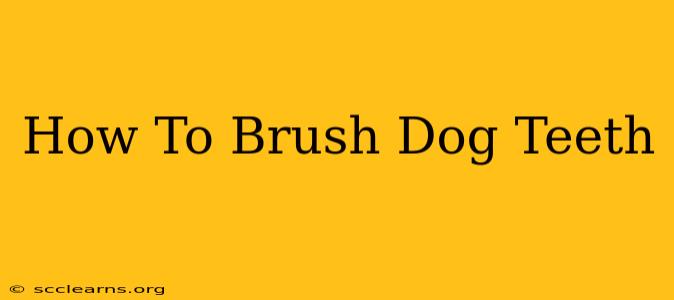Keeping your canine companion healthy involves more than just food and exercise. Dental hygiene is crucial for preventing serious health problems down the line. This comprehensive guide will walk you through the process of brushing your dog's teeth, making it a positive experience for both of you.
Why is Brushing Your Dog's Teeth Important?
Many dog owners overlook dental care, but it's a vital part of responsible pet ownership. Neglecting your dog's teeth can lead to a range of issues, including:
- Periodontal Disease: This is the most common dental problem in dogs. It's an infection of the gums and tissues supporting the teeth, leading to pain, tooth loss, and even more serious health problems.
- Bad Breath: While not a life-threatening condition, persistent bad breath (halitosis) is often a sign of underlying dental issues.
- Infections: Bacteria from infected gums can spread throughout the body, affecting organs like the heart, kidneys, and liver.
Simply put: regular brushing can significantly extend your dog's life and improve their quality of life.
Getting Started: Gathering Your Supplies
Before you begin brushing, you'll need the right tools:
- Dog-Specific Toothbrush: Avoid human toothbrushes, as they're too abrasive for a dog's sensitive gums. Look for brushes with soft bristles and a small head designed for canine mouths. Some even come with finger attachments for easier control.
- Dog Toothpaste: Crucially, never use human toothpaste. Human toothpaste contains ingredients toxic to dogs. Opt for dog-specific toothpaste, which comes in flavors dogs love, like chicken or peanut butter. These are formulated to be safe if swallowed.
Introducing Your Dog to Toothbrushing: A Gentle Approach
The key to success is gradual introduction. Don't force the issue. Here's a step-by-step approach:
Step 1: The First Taste
Let your dog lick a small amount of dog toothpaste from your finger. This helps them associate the taste with something positive. Repeat this for several days.
Step 2: Touch and Lift
Gently touch your dog's lips and teeth with your finger. Then, try lifting their lip to briefly expose their teeth. Reward them with praise and treats.
Step 3: Introducing the Brush
Once your dog is comfortable with lip and teeth handling, introduce the toothbrush. Start by gently rubbing the toothbrush along their teeth and gums with the toothpaste. Keep sessions short (15-30 seconds).
Step 4: Gradual Brushing
Gradually increase the brushing time as your dog becomes more comfortable. Aim for at least two minutes of brushing daily. Focus on all surfaces of their teeth.
Advanced Brushing Techniques
- Angle Matters: Hold the toothbrush at a 45-degree angle to the gum line for optimal cleaning.
- Work Your Way Around: Brush each tooth individually, covering all surfaces – outer, inner, and chewing surfaces.
- Positive Reinforcement: Praise and reward your dog throughout the process with treats and affection.
Alternatives to Brushing:
If brushing proves too difficult, consider these alternatives:
- Dental Chews: These can help remove plaque and tartar but shouldn't replace brushing. Look for the Veterinary Oral Health Council (VOHC) seal of approval.
- Dental Wipes: These are convenient for quick cleanings, but they don't clean as effectively as brushing.
- Water Additives: Some water additives claim to improve dental health. Consult your vet before using these products.
When to See the Vet:
Even with regular brushing, professional dental cleanings are sometimes necessary. Schedule a dental checkup with your veterinarian at least once a year. Your vet can identify any dental problems early and recommend appropriate treatment.
Regular dental care is a significant investment in your dog's overall health and wellbeing. By following these tips, you can help keep your furry friend's smile bright and healthy for years to come!

